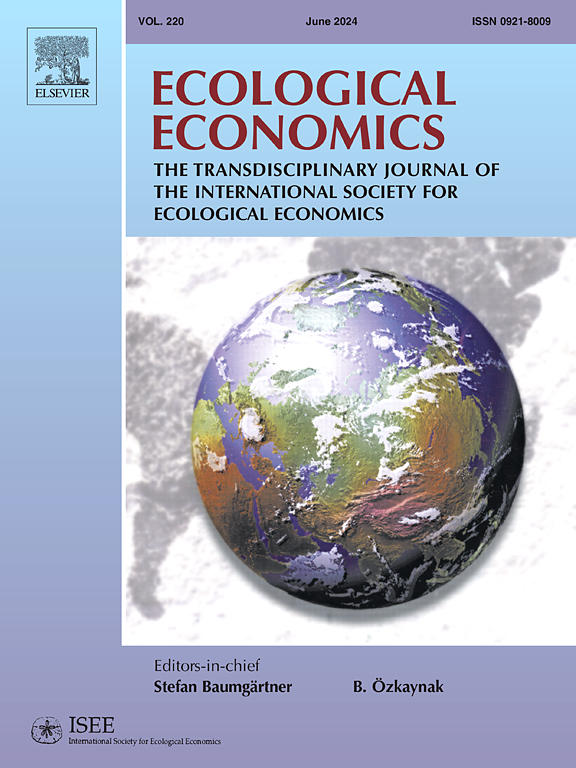通过长期绿色债券为气候适应型基础设施融资
IF 6.3
2区 经济学
Q1 ECOLOGY
引用次数: 0
摘要
随着气候变化适应措施的紧迫性加剧,为此类适应提供资金的重要性引起了相当大的关注。然而,制定有效的适应融资机制是一项复杂而艰巨的挑战。本研究旨在考察典型适应性融资框架中的几个关键要素,特别是以绿色债券为重点,以评估它们对债券发行周期设计的影响。我们开发了一个将适应策略与融资过程整合在一起的连续时间模型,并对涉及投融资的关键决策进行了理论分析,包括适应资源的分配、融资和还款结构以及发行周期。通过水电管理实例验证了该模型的有效性。此外,我们对影响绿色债券发行周期的各种关键因素进行了实证评估。研究结果表明,适应投资边际效用的增加与融资效率的提高相关,决策者需要采取主动融资策略。此外,生产效率的提高和气候不确定性的增加与债券发行周期的延长有关。我们的实证分析进一步表明,债券利率对发行周期的影响在长期债券中更为明显,这可能会鼓励企业采取更先发制人的适应策略。本文章由计算机程序翻译,如有差异,请以英文原文为准。
Financing climate-resilient infrastructure through long-term green bond
As the urgency for climate change adaptation measures intensifies, the significance of financing for such adaptations has garnered considerable attention. Nevertheless, the formulation of effective adaptation financing mechanisms presents a complex and formidable challenge. This study seeks to examine several critical elements within a typical adaptation financing framework, specifically focusing on green bonds, to assess their influence on the design of bond issuance cycle. We develop a continuous time model that integrates adaptation strategies with the financing process and perform a theoretical analysis of pivotal decisions involved in investment and financing, including the allocation of adaptation resources, financing and repayment structures, and issuance cycles. The model’s efficacy is subsequently validated through a case study on hydropower management. Furthermore, we conduct an empirical assessment of various key factors that influence the cycle of green bond issuance. Our theoretical findings indicate that an increase in the marginal utility of adaptation investment correlates with enhanced financing efficiency, necessitating that decision-makers adopt proactive financing strategies. Additionally, both heightened production efficiency and increased climate uncertainty are associated with extended bond issuance cycles. Our empirical analysis further reveals that the influence of bond interest rates on the issuance cycle is more pronounced in long-term bonds, potentially encouraging firms to pursue more preemptive adaptation strategies.
求助全文
通过发布文献求助,成功后即可免费获取论文全文。
去求助
来源期刊

Ecological Economics
环境科学-环境科学
CiteScore
12.00
自引率
5.70%
发文量
313
审稿时长
6 months
期刊介绍:
Ecological Economics is concerned with extending and integrating the understanding of the interfaces and interplay between "nature''s household" (ecosystems) and "humanity''s household" (the economy). Ecological economics is an interdisciplinary field defined by a set of concrete problems or challenges related to governing economic activity in a way that promotes human well-being, sustainability, and justice. The journal thus emphasizes critical work that draws on and integrates elements of ecological science, economics, and the analysis of values, behaviors, cultural practices, institutional structures, and societal dynamics. The journal is transdisciplinary in spirit and methodologically open, drawing on the insights offered by a variety of intellectual traditions, and appealing to a diverse readership.
Specific research areas covered include: valuation of natural resources, sustainable agriculture and development, ecologically integrated technology, integrated ecologic-economic modelling at scales from local to regional to global, implications of thermodynamics for economics and ecology, renewable resource management and conservation, critical assessments of the basic assumptions underlying current economic and ecological paradigms and the implications of alternative assumptions, economic and ecological consequences of genetically engineered organisms, and gene pool inventory and management, alternative principles for valuing natural wealth, integrating natural resources and environmental services into national income and wealth accounts, methods of implementing efficient environmental policies, case studies of economic-ecologic conflict or harmony, etc. New issues in this area are rapidly emerging and will find a ready forum in Ecological Economics.
 求助内容:
求助内容: 应助结果提醒方式:
应助结果提醒方式:


